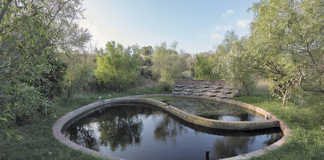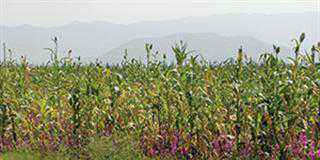
Photo: Greenhouse Technologies
The primary purpose of a greenhouse is to provide ideal conditions for year-round plant production regardless of location, weather and other environmental conditions.
While greenhouses are expensive because they are typically equipped with complex crop management systems, Shaul Rabin, managing director of South African greenhouse systems supply company Cyclone Technology, says the return on investment can be high.
He adds that factors such as climate change are key factors driving greenhouse farming around the world.
Rabin says that greenhouse farming is attractive for three main reasons: it is far more water-efficient than open-air production; sunlight can be evenly dispersed over all the plants and its intensity can be managed to suit particular crops; and temperature and humidity can be controlled.
“In addition, the ability to trellis plants is made much easier; theft of and damage to plants is minimised; air movement through a greenhouse can be controlled; and specialised lighting can be used to provide plants with any artificial light they might need.
“A greenhouse farmer can achieve the same or even better yield on a smaller area than an outdoor crop farmer can.”
Trends
Brian Sparks, editor of the US-based magazine Greenhouse Grower Technology, says the publication’s 2018 surveys of US commercial greenhouse production operations and
their suppliers identified a number of important technology trends for this sector in the US, which may be applicable across the world.
One of these is that more than 50% of the greenhouse growers surveyed want to invest significantly in technology and automation to reduce their dependency on labour, and increase their production efficiencies and profit margins.
In addition, growers are keen to invest specifically in greenhouse production automation.
These include transplanters, seeders and conveyors; greenhouse management computer software for inventory controls, logistics and crop protection; structures and coverings; irrigation equipment and controls; and growing media equipment such as pot fillers, tray fillers and soil mixers.
When asked how investing in these technologies could improve their production, they mentioned “everything from more [production cycles], to streamlining workflow and producing a more uniform crop”, Sparks says.
Participants added that these technologies would make their operations more financially and environmentally sustainable by reducing waste and energy use.
A 2018 study, ‘Advances in greenhouse automation and controlled environment agriculture: A transition to plant factories and urban agriculture’, highlights a variety of existing and anticipated technologies that can assist greenhouse farmers in achieving their profitability and sustainability goals.
Cover and light
According to the paper, the selection of covering material for a greenhouse depends on its application, the type of crop to be cultivated, and the climatic conditions of the region. It can vary from a simple cover, such as single-layer plastic or glass, to fibreglass, double-wall plastic, acrylic sheet, polyethylene film, PVC, copolymers, polycarbonate panels, or selective transmission mediums for different spectral frequencies.
The New South Wales Department of Primary Industries in Australia explains that the covering material used on a greenhouse influences the productivity and performance of a structure, affecting the quality of light available to the crop.
The paper adds that light condition and air temperature are the two most important factors for plant growth. The most common artificial light sources used in modern greenhouses are incandescent lamps; discharge lamps such as fluorescent light tubes, metal halide and high-pressure sodium lamps; and light-emitting diodes (LEDs).
Among these, LEDs have gained significant popularity due to advantages such as cost-efficiency, compact design, durability, light quality, and low thermal energy generation.
Microclimate
“An efficient greenhouse requires environment control for air quality, disease reduction, pest control, and nutrient and water uptake,” the paper states.
“In general, microclimate parameters in a controlled environment agriculture facility are manipulated by passive and active ventilation, evaporative cooling techniques, shadings, and refrigeration dehumidification.”
According to the Department of Agriculture and Forestry (DAF) in Alberta, Canada, options to provide heat in a greenhouse include forced air and boiler heat for the plant canopy, and hot water, steam, oil or glycol systems to warm a crop’s root zone.
The DAF adds that horizontal airflow fans or adjustable ridge or gutter vents in the greenhouse roof can be used to control air inflow or outflow in order to maximise air quality and prevent over- or under-humidification.
High-precision fertigation
Modern systems allow for increasingly precise applications of water and liquid-form nutrients to greenhouse crops. This optimises plant nutrition for maximum growth and yield, while reducing potentially costly waste and possible negative consequences for the natural environment.
The DAF explains that recirculating systems enhance irrigation and plant nutrition efficiencies even more. These systems collect any excess water and liquid fertiliser (leachate) not used by crop roots the first time round, sterilise it of any disease-causing organisms through ultraviolet light, ozone gas, heat pasteurisation or biofiltration, and reapply the leachate to the crops during the next scheduled fertigation.
Control systems
Two of the most helpful technological advances are automatic greenhouse monitoring and response systems, and the ability to observe and control their functioning from a remote location via computer or smartphone.
According to the study, sensor systems are available to automatically monitor a wide variety of greenhouse conditions, such as sunlight intensity and quality, air quality and composition, nutrient and moisture levels in crop root zones, and plant stress and overall health.
This data is sent to a central management computer for an appropriate automated response by the greenhouse equipment, such as the fertigation or ventilation systems.
The most popular of these automatic monitoring, evaluation and response systems are wireless sensor networks (WSN) and Internet-of-Things-based (IoT) systems.
“An important consideration in designing an efficient WSN is the number of nodes, their location, distances between nodes, the antenna, and the operating frequency based on the greenhouse microclimate condition. Studies showed that radio wave propagation is strongly affected by the high greenhouse environment,” the paper states.
The DAF cautions that the computerised system’s ability to manage a greenhouse environment optimally is only as good as the information it receives.
“It’s important that quality sensors are used and routinely maintained to ensure they are operating properly. Sensor placement is also important to ensure accurate readings of the crop environment.”
Email Shaul Rabin at [email protected].
Sources: Shamshiri RR, Kalantari F, Ting KC, Thorp KR, Hameed I A, Weltzien C, et al. 2018. ‘Advances in greenhouse automation and controlled environment agriculture: A transition to plant factories and urban agriculture’. International Journal of Agricultural and Biological Engineering. 11(1): 1–22.










